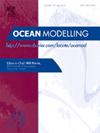A novel framework for studying oceanic freshwater transports, and its application in discerning the modelled fate of freshwater around the coast of Greenland
IF 2.9
3区 地球科学
Q2 METEOROLOGY & ATMOSPHERIC SCIENCES
引用次数: 0
Abstract
In the sub-polar North Atlantic, the accumulation of fresh meltwaters from Greenland and the Arctic can impact the strength of the climatically important Atlantic Meridional Overturning Circulation. In this study I investigate and map out the processes that contribute to the accumulation of freshwater in four different regions around Greenland, quantifying horizontal transports of freshwater and the expansion and depletion of freshwater reservoirs by surface sources and interior mixing. Rather than using traditional freshwater budgets, whose flaws are well documented, I propose the novel use of the freshwater transformation framework and apply it to outputs from an eddy resolving coupled climate model (10 km atmosphere and 5 km ocean).
Analysing volume transports in salinity space we observe the salinification of the boundary currents surrounding Greenland as they flow from Fram Strait towards the Labrador Sea. Using the freshwater transformation framework we are able to link the salinification to mixing, sea-ice formation or the accumulation of freshwaters stored in the waters surrounding Greenland. The balance changes depending upon the region and season under question. The mixing of freshwaters is found to be stronger during wintertime than in summertime. Furthermore, mixing plays a more dominant role in the freshwater transformation budget off Southern Greenland, where sea-ice cover is low, than off Northern Greenland, where sea-ice cover is high.
一个研究海洋淡水运输的新框架,及其在识别格陵兰海岸周围淡水的模拟命运中的应用
在亚极地北大西洋,来自格陵兰岛和北极的新鲜融水的积累可以影响对气候具有重要意义的大西洋经向翻转环流的强度。在这项研究中,我调查并绘制了导致格陵兰周围四个不同地区淡水积累的过程,量化了淡水的水平输送以及地表水源和内部混合导致的淡水水库的扩张和枯竭。我没有使用传统的淡水预算(其缺陷已被充分证明),而是提出了淡水转换框架的新用途,并将其应用于涡解析耦合气候模式(10公里大气和5公里海洋)的输出。通过分析盐度空间的体积输送,我们观察到格陵兰岛周围的边界流从弗拉姆海峡流向拉布拉多海时的盐碱化。利用淡水转化框架,我们能够将盐碱化与混合、海冰形成或储存在格陵兰周围水域的淡水积累联系起来。平衡的变化取决于所讨论的地区和季节。人们发现,冬季淡水的混合比夏季更强烈。此外,在海冰覆盖较少的南格陵兰海域,混合在淡水转化预算中比海冰覆盖较多的北格陵兰海域起着更大的作用。
本文章由计算机程序翻译,如有差异,请以英文原文为准。
求助全文
约1分钟内获得全文
求助全文
来源期刊

Ocean Modelling
地学-海洋学
CiteScore
5.50
自引率
9.40%
发文量
86
审稿时长
19.6 weeks
期刊介绍:
The main objective of Ocean Modelling is to provide rapid communication between those interested in ocean modelling, whether through direct observation, or through analytical, numerical or laboratory models, and including interactions between physical and biogeochemical or biological phenomena. Because of the intimate links between ocean and atmosphere, involvement of scientists interested in influences of either medium on the other is welcome. The journal has a wide scope and includes ocean-atmosphere interaction in various forms as well as pure ocean results. In addition to primary peer-reviewed papers, the journal provides review papers, preliminary communications, and discussions.
 求助内容:
求助内容: 应助结果提醒方式:
应助结果提醒方式:


